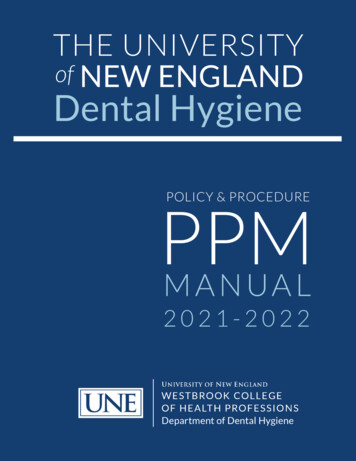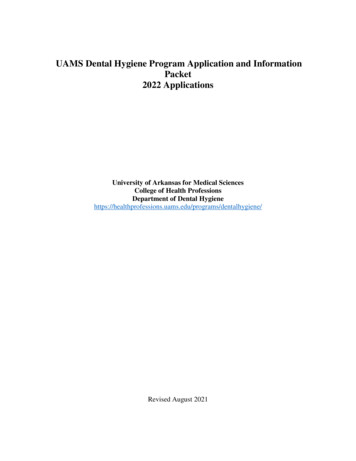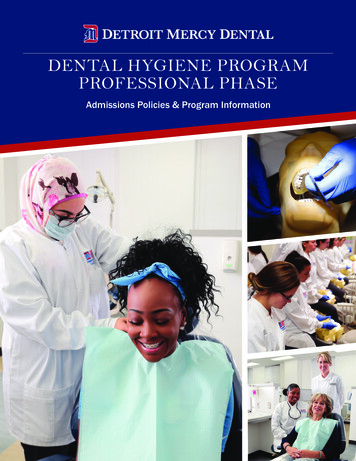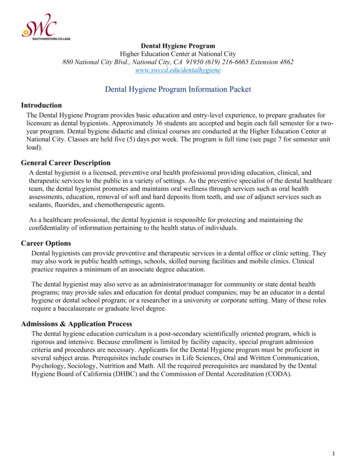
Transcription
EU SHIP SANITATION TRAINING NETWORK - SHIPSAN TRAINET PROJECT (2007206)European Manualfor Hygiene Standardsand Communicable DiseasesSurveillance on Passenger ShipsEuropean Commission Directorate General for Health and ConsumersWork package: 5Deliverable: 9LARISSAOCTOBER 2011OCTOBER 2011
European Manual for HygieneSurveillance on Passenger ShipsStandardsandCommunicableDiseasesEU SHIPSAN TRAINET project work package 5Deliverable 8Larissa, October 2011Lead partnersUniversity of Thessaly, GreeceNational School of Public Health, GreeceAssociated partnersCentro Nacional de Epidemiologia, SpainCMT Prooptiki Ltd, GreeceHamburg Port Health Center, GermanyHealth Protection Agency, United KingdomHealth Protection Inspectorate, EstoniaHealth Protection Surveillance Centre, IrelandInstitute of Public Health, SloveniaKlaipeda Public Health Center, LithuaniaMedical University of Gdansk, PolandMinistry of Health, Section of Communicable Diseases Surveillance, BulgariaNational Board of Health and Welfare, SwedenThis Manual arises from the EU SHIPSAN TRAINET project which has received funding from the EuropeanUnion, in the framework of the Public Health Programme.
European Manual for Hygiene Standards on Passenger Ships2
European Manual for Hygiene Standards on Passenger Ships3This Manual was produced under work package 5 of the SHIPSAN TRAINET project and was coordinated bythe Department of Hygiene and Epidemiology of the University of Thessaly in Greece. Members of thecoordination team were: Prof. C. Hadjichristodoulou, V.A. Mouchtouri, PhD, E. Kostara, MSc, P. Tserkezou,MSc, and Prof. J. Kremastinou.The following working group members were responsible for procuding this .J.C.M.M.O.C.S.Arvanitoyannis, University of Thessaly, GreeceBartlett, University College London, United KingdomBlack, LaRS, Health Protection Agency, United KingdomChavoshi, National Board of Health and Welfare, SwedenGennata, University of Thessaly, Department of Medicine, GreeceJaremin, Interfaculty Institute of Maritime and Tropical Medicine in Gdynia, PolandKoureas, University of Thessaly, Department of Medicine, GreeceLamshoeft, Hamburg Port Health Center, GermanyLaunders, Health Protection Agency, United KingdomLee, European Working Group for Legionella Infections, United KingdomMastroyiannakis, CMT Prooptiki, GreeceMcGrath, Health Protection Surveillance Centre, IrelandMollergren, National Board of Health and Welfare, SwedenNichols, Health Protection Agency, Centre for Infections, United KingdomPaux, Ministry of Health, FrancePirnat, Institute of Public Health, SloveniaPinaka, University of Thessaly, Department of Medicine, GreecePlemp, National Institute for public health and the Environment, the NetherlandsRachiotis, University of Thessaly, Department of Medicine, GreeceRiemer, Hamburg Port Health Center, GermanyRjabinina, Health Protection Inspectorate, EstoniaSchlaich, Hamburg Port Health Center, GermanySkipp, Carnival Cruises, United KingdomSocan, Institute of Public Health, SloveniaSokolova, Klaipeda Public Health Centre, LithuaniaVarela Martinez, Centro Nacional de Epidemiologia, SpainWestacott, Association of Port Health Authorities, Southampton Port Health Authority, United KingdomThe Editorial Board of this manual constisted of the following members:C.L.R.C.J.J.D.L.G.S.T.M.C.Bartlett, University College London, United KingdomHadjichristodoulou, University of Thessaly, Department of Medicine, GreeceKremastinou, National School of Public Health, GreeceKutil, Carnival Cruises, USAMenucci, World Health Organization, FranceNichols, Health Protection Agency, Centre for Infections, United KingdomRehmet, European Centre for Disease Prevention and Control, SwedenSkinner, MSC CruisesSkipp, Carnival Cruises, United KingdomVarela Santos, European Centre for Disease Prevention and Control, Sweden
European Manual for Hygiene Standards on Passenger Ships4The Working Group is grateful for all comments and contributions to this manual that have been received by the followingmembers of the SHIPSAN TRAINET partnership:P.Aarsen, Paris Memorandum of Understanding, the NetherlandsJ.Ames, Centres for Diseases Control and Prevention, Vessel Sanitation Program, United States of AmericaR.Andragetti, World Health Organization, FranceR.Begel, MSC Cruise LineP.Best, PB Environmental Health, United KingdomN.Bitsolas, University of Thessaly, Department of Medicine, GreeceS.Brown, P&O FerriesW.Bunia-Corbetta, ADS Insight, Brussels, BelgiumK.Bunyan, Carnival Cruises, United KingdomG.Cartledge, United Kingdom Ferry Industry/PSAR.Catt, P&O Cruises, United KingdomT.Chodnik, Interfaculty Institute of Maritime and Tropical Medicine in Gdynia, PolandS.Collins, Cruise Lines International Association, Florida, USAD.Coulombier, European Centre for Disease Prevention and Control, SwedenV.Croskey, Holland America LineM.Dávila Cornejo, Ministry of Health, SpainE.Depoortere, European Centre for Disease Prevention and Control, SwedenM.Dietl, AIDA Cruise line, GermanyJ.M.Di Guardia, Direction Générale de la Santé, FranceD.Di Marco, Costa Crociere, ItalyA.Diskin, Royal Caribbean Royal Caribbean International, Azamara Cruise Club, Celebrity CruisesM.Do Ceu Madeira, Ministry of Health, PortugalR.Evenhand, Silversea CruisesD.Gavrilis, Ionian University – Athena Research Centre, GreeceG.Georgalas, Department of Health, CyprusC.Gonzalez, Oceania Cruises/Regent Seven Seas CruisesC.Hadjipetris, Louis cruises, CyprusM.Hagger, Pullmantur Cruises Ship Management Ltd.I.Hay, Anchor Hygiene Services Limited, Cohesive Public Health Support, London, United KingdomP.Henry, Health Protection Surveillance Centre, IrelandM.Hrsak, Carnival Cruise LinesF.Jourdain, Direction Générale de la Santé, FranceA.Kantonis, Ministry of Health, CyprusM.Kivi, World Health Organization, FranceA.Kotłowski, Interfaculty Institute of Maritime and Tropical Medicine in Gdynia, PolandC.Koutis, Technological Educational Institute of Athens, GreeceA.Kunchev, Ministry of Health, BulgariaJ.Kutil, Carnival Corporation & plcT.Lammerding, AIDA cruise line, GermanyA.Lavruvianec, Klaipeda Public Health Center, LithuaniaE.Malissiova, University of Thessaly, GreeceH.Maltezou, Hellenic Centre for Infectious Diseases Control and Prevention, GreeceT.Marking, European Cruise Council, BelgiumR.Marshall, Royal Caribbean International & Celebrity CruisesJ.BMcGruer, Royal Caribbean Cruises, United Kingdom LTDR.Meilicke, Health and Consumer Protection Directorate C/Unit C1 Programme Management, LuxembourgD.L.Menucci, World Health Organization, FranceN.Mikelis, International Maritime Organization, United KingdomL.Nodarse, Apollo ShipsC.Papatheodorou, Ionion University, GreeceA.Pavli, Hellenic Centre for Infectious Diseases Control and Prevention, GreeceC.Penny, Fred Olsen Cruise LinesM.Quintana –Gomez, SAGA Shipping Company Ltd.S.Rehmet, European Centre for Disease Prevention and Control, SwedenM.Recinos, Pullmantur Ship ManagementM.Rivas, Royal Caribbean Royal Caribbean International, Azamara Cruise Club, Celebrity CruisesF.Russo, MSC CruisesM.Saeme, Silversea/Seabourn/SeaDream/Windstar CruisesA.Shatalova, Latvian State Public Health Agency, Riga branch, LatviaT.Skinner, MSC CruisesA.Slepetiene, Klaipeda Public Health Centre Department of Public Health Safety Control, Lithuania
European Manual for Hygiene Standards on Passenger ShipsI.I.G.S.N.T.C.J.G.S.C.L.N.N.D.S.D.M.Smith, Carnival Cruise LinesSnijders, Paris Memorandum of Understanding, the NetherlandsSpala, Hellenic Centre for Infectious Diseases, Control and Prevention, GreeceStannard, Carnival United KingdomStewart, Carnival Cruises, United KingdomStrang, Carnival Cruises, United KingdomSwaan, RIVM – National Institute for PH and the Environment, the NetherlandsTakkinen, European Centre for Disease Prevention and Control, SwedenTarling, Princess CruisesTomaszunas, Interfaculty Institute of Maritime and Tropical Medicine in Gdynia, PolandVarela Santos, European Centre for Disease Prevention and Control, SwedenVerhoef, DIVINE-NET, the NetherlandsVozelevskaja, Health Protection Service of Tallinn, EstoniaWang, World Health Organization, FranceWagner, International & Strategic Coordination, Primary Health Care & Crisis Management, BelgiumWilliams, Royal Caribbean International, Miami, Florida, USAZamfir, Louis cruises, CyprusZisiopoulou, University of Thessaly, Department of Medicine, Greece5
European Manual for Hygiene Standards on Passenger QSOLASSTVATVOCVSPWHOWSPAcute Respiratory IllnessCritical Control PointColony Forming UnitCritical LimitCruise Line International AssociationChest X-RaysExecutive Agency for Health and ConsumersEuropean CommissionEuropean Cruise CouncilEuropean Centre for Disease Prevention and ControlEuropean Legionnaires’ Disease Surveillance NetworkEuropean Programme for Intervention Epidemiology TrainingEuropean UnionEuropean Union Member StatesEuropean Working Group on Legionella InfectionsEarly Warning and Response SystemFood and Agriculture OrganizationFeline CalicivirusFirst in – First outGastrointestinal IllnessHazard Analysis Critical Control PointInternational Health Regulations 2005Influenza-Like IllnessInternational Labor OrganizationInternational Maritime Dangerous GoodsInternational Maritime OrganizationIntegrated Pest ManagementInternational Organization for StandardizationInternational Water AssociationInternational Convention for the prevention of pollution from shipsMaritime Declaration of HealthNephelomeric Turbidity UnitOutbreak Management PlanPersonal Protective EquipmentPassenger Shipping AssociationPolyvinyl ChlorideQuaternary Ammonium CompoundRecreational Water FacilitiesRequirementSafety of Life at SeaRecommended StandardValue Added TaxVolatile Organic CompoundsVessel Sanitation ProgramWorld Health OrganizationWater Safety Plan6
European Manual for Hygiene Standards on Passenger Ships7Table of contentsAbbreviations 6i.Introduction 11ii.Purpose and audience of the manual 11iii.Manual structure and format 12iv.Administrative procedures 12Part A17Definitions 191.Medical facilities 292.Communicable diseases surveillance 333.Food safety 413.13.23.33.43.53.6Hazard Analysis and Critical Control PointFood handlersGeneral requirements for food preparation areasSource/storage/preparation/service of foodstuffsEquipment and utensilsCleaning, disinfection and storage of working utensils and equipment4.Potable water safety 734.14.24.34.4Introduction to Water Safety PlanSystem assessmentOperational monitoringManagement plan5.Recreational water safety 856.Pest management 977.Housekeeping and facilities 1017.17.27.37.47.57.6Accommodation and public spacesToilets and hand washing facilitiesNursery and play areasHairdressers, beauty salons and gymsPet/animal housing areasLaundry8.Hazardous substances 1139.Waste management 1179.19.29.39.49.5All types of wastesGarbageSewage and grey waterHazardous wasteMedical 20122123
European Manual for Hygiene Standards on Passenger Ships10.8Ballast water management 127Reference list – Part A 129Part B135Guideline I 137Prevention and control of influenza-like illness on passenger ships 137A. Guidelines for the prevention and control of seasonal influenza on passenger ships 1381Pre-embarkation 1382During the voyage 1393Before disembarkation 1454After disembarkation 1465Competent authorities’ actions 146B. Specific guidance during an influenza pandemic 148Reference list 150Guideline II 153Prevention and control of gastroenteritis on passenger ships 1531Overview 1532How to differentiate gastroenteritis outbreaks 1543Modes of transmission of gastrointestinal illness 1554Activity plan 1565Everyday preventive measures/actions 1575.1Level 0 Everyday preventive measures/actions by the ship 1575.2Level 0 Everyday preventative action by shipping companies 1595.3Level 1 Low-level gastroenteritis activity – action by the ship 1596Level 2 Management of an outbreak 1596.1Level 2 Management of an outbreak – actions by the ship 1596.2Level 2 Outbreak action by others (agencies and owners) 1617Level 3 After the outbreak action 1618Further guidance 161Reference list 161Guideline III 163Prevention and control of legionellosis on passenger ships 1631Overview 1632Legionnaires' disease prevention and control on ships 1652.1Every day preventive measures on board ships 165
European Manual for Hygiene Standards on Passenger Ships92.1.1Medical issues 1652.1.2Environmental health preventive measures 1672.2Case/cluster/outbreak management 1702.2.1Medical issues 1702.2.2Environmental measures 1712.2.3Measures to be taken before disembarkation 1732.2.4After disembarkation measures 1732.3Port competent authority actions 173Reference list 175Annexes 177Annex 1: Administrative issues – Possible permanent implementation of the inspection programme 178Annex 2: Hygiene inspection guidelines 180Annex 3: Record keeping and training for crew included in the Manual 184Annex 4: Corrective action report 187Annex 5: Recommended medical facilities, medication and medical staff competency for passenger shipsmaking international voyages 189Annex 6: Surveillance of communicable diseases on board ships 191Annex 7: Gastrointestinal illness log (recommended log) 192Annex 8: Influenza-like illness log (recommended log) 193Annex 9: Gastrointestinal illness questionnaire 194Annex 10: Case/Outbreak recording form 196Annex 11: Communicable diseases surveillance routine recording form 200Annex 12: Identification of physical, chemical and microbiological hazards for food 201Annex 13: Model training plan 202Annex 14: Hand washing method 205Annex 15: Guidance on production and use of water safety plans 206Annex 16: Suggested competences for the training of crew responsible for the WSP implementation 212Annex 17: Parameters for water quality monitoring (Directive 98/83/EC) 213Annex 18: Recommended Faecal and Vomit Accident Release Plan 216Annex 19: Rules for sampling and testing of water from recreational water facilities 217Annex 20: Suggestions for corrective actions to be taken in case of water quality parameters out of limits inrecreational water facilities 218Annex 21: Examples of health advisory signs for recreational water facilities 219Annex 22: Guidelines for the determination and assessment of risk of hazardous chemical agents [Directive98/24/EC] 220Annex 23: Background information for influenza 221Annex 24: Model health questionnaires for screening persons before embarkation 223
European Manual for Hygiene Standards on Passenger Ships10Annex 25: Examples of informative leaflet for the pandemic A(H1N1) 2009 influenza virus 225Annex 26: Example of calculating the ili threshold levels of an outbreak 227Annex 27: Examples of preventive measures for gastroenteritis infections including norovirus 228Annex 28: Example of hazard analysis in prevention of gastroenteritis transmission on board ship 229Annex 29: Disinfectants 230Annex 30: Cleaning and disinfection procedures for dealing with potentially contaminated surfaces 232Annex 31: Suggested content of an Outbreak Management Plan (OMP) 234Annex 32: Epidemiology of gastrointestinal illness on board passenger ships 235Annex 33: Background information on Legionnaires’ disease and Legionella spp. 236Annex 34: Chlorine disinfection procedures of water tanks and distribution system (EWGLI 2005) 238Annex 35: Thermal disinfection procedures of hot water tanks and distribution system (EWGLI 2005) 239Annex 36: Personal Protective Equipment 241Annex 37: Legionnaires’ disease case investigation questionnaire 242Annex 38: Sampling guidelines (EWGLI 2005) 245Index:248
European Manual for Hygiene Standards on Passenger Ships11i. IntroductionIn 2009, approximately 390 million passengers ferry trips were recorded through European portsand 188 cruise ships were domiciled or participated in the European cruise ship market. TheEuropean cruise market has grown by 41% from 2006 to 2009 and more than doubled over the last10 years. A considerable proportion of the European population travels in modern ships, which arebecoming more complex and are designed to carry many more passengers and crew.Ships move continuously from one country to another where different standards of sanitation arerequired. These differences can cause administrative difficulties for competent authorities ofcountries, as well as for ship companies, when trying to deal with the prevention and control ofcommunicable diseases on board ships. Therefore, there is a need for standards regarding healthrelated issues, which can be adopted and accepted by all European Union Member States (EUMS).The SHIPSAN project (No A/790577) study revealed a diversity of approaches and practices in theconduct of ship inspections, differences in the competencies of inspectors and the legislationapplied during inspections, and a lack of communication and training among many EUMS. Commoninspection tools at a European level for hygiene inspection practices and port to port communicationwere recommended.This document is Deliverable No 8 produced under work package 5 of the SHIPSAN TRAINETproject. Ten working groups were established for the development of this document withparticipants/experts from 17 European countries. The European Centre for Disease Prevention andControl (ECDC), the World Health Organization (WHO), the International Maritime Organization(IMO) and the US Vessel Sanitation Program (VSP) also provided input. The European CruiseCouncil (ECC), the Cruise Lines International Association (CLIA) and individual cruise and ferrycompanies have also contributed to the development of this document.The content of the manual was based on expert opinion consensus reached during working groupmeetings and on EU legislation and International Health Regulations 2005 (IHR) requirements. TheSHIPSAN project (No A/790577) study results, literature review and analysis of collected data onpolicies, guidelines and practices implemented by the EUMS were also used to develop this manual.ii. Purpose and audience of the manualThe EU SHIPSAN TRAINET project manual incorporates hygiene standards based on EU legislationand brings together best practice guidelines for passenger ships sailing within European waters.The purpose of this manual is to collaborate with the industry and competent authorities indeveloping and implementing comprehensive sanitation programmes, using current legislativeframeworks, in order to minimise the risk of communicable diseases. It also gives guidance oncommunicable disease surveillance on board ships. Compliance with the hygiene standards and bestpractice guidelines of the manual can help to improve and maintain: a) the hygiene level on boardpassenger ships sailing to or within the EU waters, b) the level of compliance with hygienestandards that are included in the existing EU legislation, and c) the safety of food, water andenvironmental conditions for passengers and crew.
European Manual for Hygiene Standards on Passenger Ships12This manual is intended for passenger shipping companies and public health inspectors in Europeanports, who are responsible for passenger ship inspections. Hygiene inspections of passenger shipsare conducted by assessing conditions observed against the criteria contained within Chapters 1 to10, of Part A of this manual, excluding the Annexes.The SHIPSAN TRAINET project put into action a pilot implementation of the manual in 2010-11,before producing this final version. The following countries participated in the pilot phase: Cyprus,Estonia, Germany, Greece, Italy, Malta, Spain, the Netherlands and Turkey. During the six monthspilot implementation, potential amendments were identified. These were included in the pilotimplementation report and were revised in the SHIPSAN TRAINET manual.Training based on this manual was provided to port health officers of the competent authorities, aswell as ships’ crews, in order to harmonise inspection practices in EUMS and to help industry withimplementation of EU legal standards and best practice.The SHIPSAN TRAINET project has developed a communication system in close collaboration withselected competent authorities in the EUMS and shipping companies. This facilitates the exchangeof enhanced information through the normal channels in each of the EUMS involved in the project.iii. Manual structure and formatThis document consists of two Parts:Part A describes the standards for hygiene inspections and communicable disease surveillance onboard ships. These standards are a compilation of existing legislation, procedures and best practice.Each chapter of the manual starts with a short introduction and continues with the detaileddescription of requirements and recommended standards. For each requirement or recommendedstandard a numbered short phrase has been provided on the left side of the page. On the right sideof each page the abbreviations “RQ” (requirement) or “ST” (recommended standard) are providedin order to assist the user to easily distinguish legal requirements from SHIPSAN recommendedstandards. Requirements are necessities that must be implemented on board in order to complywith EU legislation. Recommended standards represent good practices, which are not currentlylegislated but the implementation of which will help ensure a high level of hygiene. Excerpts andreferences to legal documents of the EU and international legislation are provided at the end ofeach chapter.Part B includes guidelines for the management of communicable disease on board passenger ships.Specific guidelines are given for dealing with influenza-like illness (ILI), general considerations forinfluenza pandemics, Legionnaires’ disease and gastroenteritis.iv. Administrative proceduresThe administrative procedures below are designed to be used by the trained competent authorisedinspectors of competent authorities, who conduct the inspections against the criteria set out in themanual. They will also be of use to the passenger ship industry in order to prepare for possibleinspections.
European Manual for Hygiene Standards on Passenger Ships13Some issues for permanent implementation of the inspection programme are described in Annex 1in order to give a future perspective for a possible permanent implementation.Participating authoritiesCompetent authorities from each country that collaborate with SHIPSAN participate in the networkand carry out inspections.Inspection team – competency and authorisationOnly officers authorised as competent by their EUMS, who have undertaken appropriate training intheir own EUMS and received additional training from SHIPSAN TRAINET, will conduct theinspections. The selection criteria for the inspectors who will be involved in the inspections havebeen developed by the SHIPSAN TRAINET network working group in consultation with the EUMS.Professional activities, educational qualifications, ability to communicate effectively with the shipcrew, previous experience, continuing professional development and scientific activities formed thebasis of the criteria for selecting the inspection team members. The inspection team in each countryis appointed by the EUMS, taking into consideration the selection criteria developed by the SHIPSANTRAINET network working group.Frequency of inspectionsIt has been decided that the frequency of SHIPSAN routine inspections will be specified as oneinspection every six months. In the future, the frequency can be calculated by using a riskassessment procedure.Standardisation of inspectionsInspection procedures are described in Annex 2. The use of a standardised inspection form(inspection outlines) during the inspection is considered necessary in order to ensure consistentimplementation of inspection procedures, to reduce the subjectivity of the implementation ofstandards, and to record the inspection findings in a consistent manner. Standardised inspectionforms (inspection outlines) will be used for each topic (food safety, potable water safety etc.). Theinspection outlines are based on the hygiene standards included in the manual and generally basedon existing European legislation. A summary table describing all record keeping included in themanual can be found in Annex 3.The standardised inspection report will include deficiencies which are based on both legalrequirements (RQ) and recommended standards (ST) as these constitute the overall SHIPSANstandards. Part B of this manual is for guidance only and will not form part of SHIPSAN inspections.Annexes provide supplementary material that can help both inspectors and the passenger shippingindustry.
European Manual for Hygiene Standards on Passenger Ships14Scoring or grading or pass and fail system for the inspection resultsThe scoring system will be pilot-tested on an experimental basis. The inspection results will begraded (A, B, C, D). The grade will be based only on the standards set out in part A, Chapters 1 to10 of this manual. When a ship obtains a D grade, it will be considered that it has failed theSHIPSAN inspection and does not comply with the standards on which the manual is based (Annex2).Deficiencies related to Ship Sanitation Control Certificates/Ship Sanitation ControlExemption Certificates (SSCC/SSCEC) under the IHRIf the port is authorised to iss
S. Collins, Cruise Lines International Association, Florida, USA D. Coulombier, European Centre for Disease Prevention and Control, Sweden V. Croskey, Holland America Line M. Dávila Cornejo, Ministry of Health, Spain E. Depoortere, European Centre for Disease Prevention and Control, Sweden M. Dietl, AIDA Cruise line, Germany











